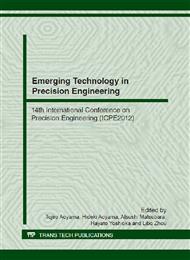p.209
p.215
p.220
p.226
p.232
p.238
p.244
p.250
p.256
High Efficiency and Eco-Friendly Heat Treatment of Small Parts with a Low-Power Diode Laser Beam
Abstract:
Demand is increasing for the manufacturing and machining of small mechanical parts. We focus on using a multi-functional desktop-sized machine tool to meet such demands because power consumption is decreased when they are machined. However, few reports have focused on heat treatment among manufacturing processes, we investigate the laser heat treatment of small parts as a highly efficient and eco-friendly method and propose in-situ heat treatment on a desktop-sized machine tool using a low-power diode laser beam. We quenched a small thin steel plate with a 30 W diode laser source. Our proposed method makes it feasible to quench a small thin steel plate and effectively reduces the power consumption of in-situ heat treatment by a desktop-sized machine tool.
Info:
Periodical:
Pages:
232-237
Citation:
Online since:
November 2012
Authors:
Price:
Сopyright:
© 2012 Trans Tech Publications Ltd. All Rights Reserved
Share:
Citation:


